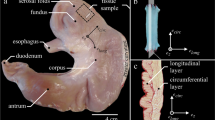Abstract
The mechanical response to external loading of a particular soft extensible tissue, the cat's mesentery, has been determined.First the hysteretic behavior of thein situ mesenteric membrane was measured and compared with the response of excised membrane. The response of the lving tissuein situ differed markedly from that of the excised tissue both with respect to the magnitude of response and with respect to ability to recover following a cycle of loading. It was observed that the tissue continuously degraded, i.e., suffered a decrease in modulus, if the overall sequence of loading cycles was continuous. However, with a recovery period of about 5 min between loading cycles, thein situ tissue would either completely or largely recover its initial cycle response. The excised tissue did not show significant (i.e., 0–15%) recovery in a coressponding time interval.
The tension in the tissuein situ was not unique but could vary significantly according to the physical condition of the membrane per se as well as the state of the gut and the large blood vessels. The most nearly unique length of the tissue which could be measured by these experimental methods was a relaxed length determined by excising a rectangular piece of tissue of known dimensions and then immediately measuring the freely floating (in a physiologic solution) dimensions to which the tissue relaxed. There was no marked material anisotropy in the plane of the membrane, i.e., two principal dimensions in the plane of the excised mesentery did not vary by more than 5% even with wide history variations just prior to excision. This relaxed length of the excised tissue has been used in normalizing the stretch in the hysteresis plots for the tissue.
Photomicrographs of the living tissue were taken during the course of the mechanical loading cycles. These concomitant observations on structural changes (visible in the light microscope) were correlated with the force-stretch plots to determine the extent to which they could be used to explain the hysteresis.
Similar content being viewed by others
References
Blatz, P. J., Chu, B. M., andWayland, H. On the mechanical behavior of elastic animal tissue.Transactions of the Society of Rheology 1969,13, 83–102.
Buchthal, F., andRosenfalck, P. Elastic properties of striated muscle. In J. W. Remington (Ed.),Tissue elasticity. Washington, D. C.: American Physiological Society, 1957.
Bull, H. B. protein structure and elasticity. In J. W. Remington (Ed.),Tissue elasticity. Washington, D. C.: American Physiological Society, 1957.
Chu, B. M. Rheological properties of soft extensible animal tissue in both living and excised states. Ph. D. thesis, 1970. Pasadena, CA.: California Institute of Technology. University Microfilm No. 70-12445.
Frasher, W. G., and Wayland, Harold. A repeating modular organization of the microcirculation of cat mesentery.Microvasculature Research, in press.
Fung, Y.-C. B. The elasticity of soft tissues in simple elongation.American Journal of Physiology 1967,213, 1532–1544.
Lee, J. S., Frasher, W. G., andFung, Y.-C. Comparison of elasticity of an arteryin vivo and in excision.Journal of Applied Physiology 1968,25, 799–801.
Patel, D. J., DeFreitas, F. M., Greenfield, J. C., andFry, D. L. Relationship of radius to presure along the aorta in living dogs.Journal of Applied Physiology 1963,18, 1111–1117.
Patel, D. J., Janicke, J. S., andCarew, T. E. Static anisotropic elastic properties of the aorta in living dogs.Circulation Research 1969,25, 765–779.
Peterson, L. H., Jensen, R. E., andParnell, J. Mechanical properties of arteries in vivo.Circulation Research 1960,8, 622–639.
Prager, W. On the formulation of constitutive equations for living soft tissues.Quarterly of Applied Mathematics 1969,27, 128–134.
Remington, J. W. Hysteresis loop behavior of the aorta and other extensible tissues.American Journal of Physiology 1955,180, 83–95.
Remington, J. W. Extensibility behavior and hysteresis phenomena in smooth muscle tissues. In J. W. Remington (Ed.),Tissue elasticity, Washington, D. C.: American Physiological Society, 1957.
Sheehan, D. The clinical significance of the nerve endings in the mesentery.The Lancet 111 1933(a).1, 409–413.
Sheehan, D. The afferent nerve supply of the mesentery and its significance in the causation of abdominal pains.Journal of Anatomy 1933(b),58, 233–249.
Stacy, R. W. Reaction rate kinetics and some tissue mechanical properties. In J. W. Remington (Ed.),Tissue elasticity. Washington, D. C.: American Physiological Society, 1957.
Trapold, J. H.: Effect of ganglionic blocking agents upon blood flow and resistance in the superior mesenteric artery of the dog.Circulation Research 1956,4, 718–723.
Author information
Authors and Affiliations
Additional information
This work was partially supported by NIH Research Grant HE08977. Financial support from USPHS Training Grant ES00004 and California Institute of Technology President's Fund 009 is gratefully acknowledged.
Rights and permissions
About this article
Cite this article
Chu, B.M., Frasher, W.G. & Wayland, H. Hysteretic behavior of soft living animal tissue. Ann Biomed Eng 1, 182–203 (1972). https://doi.org/10.1007/BF02584206
Received:
Issue Date:
DOI: https://doi.org/10.1007/BF02584206




